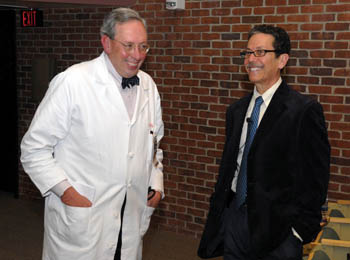
Eric Neilson, M.D., left, shares a laugh with guest lecturer Ronald Evans, Ph.D., at last week's Discovery Lecture, sponsored by the Department of Medicine. (photo by Dana Johnson)
Mice offer clues to staying lean
It's not often that a scientist sees his data featured on ESPN's SportsCenter. But when Ron Evans, Ph.D., and colleagues genetically engineered mice that could run farther and longer than normal mice, video footage of these “marathon mice” made the show.
“Athletes were extremely interested in these results,” said Evans during last week's Discovery Lecture, sponsored by the Department of Medicine.
The findings also raised concerns at the World Anti-Doping Agency about the potential for “gene-doping” — injecting the gene the investigators used to increase endurance, said Evans, a professor at the Salk Institute for Biological Studies and investigator of the Howard Hughes Medical Institute. He and colleagues are now developing a gene-doping test.
Evans and colleagues didn't set out to enter the world of athletes and doping. Their goal was to use nuclear receptors as tools to alter metabolic function in targeted tissues – as a way to understand the role of the receptors and the nature of the physiologic processes themselves, he said.
The group has a particular interest in fat “balance” and has focused on receptors called PPARs that play a role in the processes of storing and burning energy.
“We know this molecular switch — PPAR-delta — can increase fat burning, so we wanted to create a mouse and see if we could increase its endurance by promoting fat burning,” Evans said. The idea, he explained, was to try to increase the number of “slow-twitch” muscle fibers – the type that burn fat and power marathoners.
The experiment worked: mice engineered to express more PPAR-delta in their muscles ran an hour longer and twice the distance of their control counterparts on a treadmill test. The “marathon mice” were also resistant to weight gain, even when they ate a high-fat diet.
An experimental drug that activates PPAR-delta has similar protective effects against weight gain, even in inactive animals, but the drug alone does not increase endurance in mice, Evans said.
Understanding the dynamics of fat metabolism could offer new avenues, such as the experimental PPAR-delta drug, for combating obesity and the metabolic disease linked to it, a group of symptoms including high blood lipids, insulin resistance, atherosclerosis and hypertension.
For a complete schedule of the Discovery Lecture Series and archived video of previous lectures, go to www.mc.vanderbilt.edu/discoveryseries.













